The beginner of modern-day hybrid vehicles, Toyota Prius. In its fourth generation it upgrades the ecologically noble mission by understanding the driver. All drivers, not just those most economical. It remains an ecologist, but with a more decisive driving experience.
2016 Toyota Prius in brief…
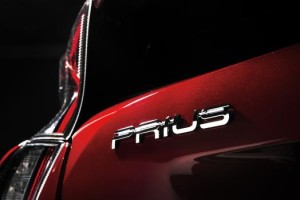
Over 3.5 million sales between 1997 and 2015
Predecessors: 1st generation (1997-2003), 2nd generation (2003-2009), 3rd generation (2009-2015)
Production: Tsutsumi (Japan)
Sales: 3.5 million (1997-2015)
Highlights, fourth generation (XV50):
– The first Toyota, which was created on a new modular platform TNGA (Toyota New Global Architecture).
– Larger and more spacious cabin with improved driving position and large luggage compartment with a basic volume of 501 liters.
– Much better driveability, more precise handling and much more responsive drive.
– Lighter, 60 percent torsionally stiffer and firmer body, 2.5 centimeters lower center of gravity.
– Improved aerodynamics for a quieter and more economical ride with active elements (flaps in the mask) and an impressive 0.24 drag coefficient.
– Average fuel consumption of 3 to 3.3 liters per hundred kilometers, the average carbon dioxide emissions of 70 to 76 grams per kilometer.
– 1.8-liter gasoline four-cylinder engine with a maximum of 40 percent thermal efficiency.
– Smaller and lighter nickel-metal hydride battery (NiMH) with a capacity of 1.31 kilowatt hours, which charges 28 percent more efficient and is fully stored under the rear seat. Because of this, luggage compartment has acquired an additional 56 liters.
– An electric motor and a continuously variable transmission with planetary interface and generators are compact and lightweight. The new design of the planetary gear unit with additional gear system and the shaft has a 20 percent smaller mechanical loss and smoother operation.
– The prius is now able to “sail” with released gas pedal up to a speed of 110 kilometers per hour on electricity alone. However, pure electric drive is available up to a speed of 60 kilometers per hour.
– High level of active and passive safety. The new Toyota Prius is able to avoid the accident, the surrounding traffic is monitored by three radars, two cameras, sonar and 17 different sensors.
The Prius is Toyota’s most important model
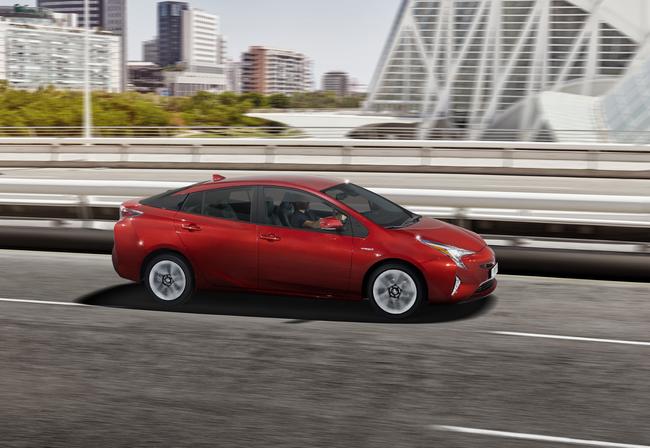
Toyota Prius achieved a lot in its 18 years of existence.
For the largest automobile manufacturer in the world Prius is the most important model. As the father of all modern-day high volume serial hybrids, Toyota Prius proved that the car may be economical and energy efficient outside of the diesel world.
Toyota engineers talk extremely respectfully about their efficiency flagship model. They say that the famous Project 21 opened new horizons and lead Toyota on a new path, which has become one of the key pillars of modern mobility.
One of the key Toyota’s eco-visionaries, President Takeshi Uchiyamada, who was at the time of Prius birth a development engineer. He vividly remembers the Christmas season almost twenty years ago, when engineers were trying to revive a prototype of the new era car ecologist for 49 days straight. “We did not know what was wrong, so every day we worked late into the night to determine the cause. Around Christmas we have finally put it in motion, but it was able to drive only 500 meters!”
We have to admit that Toyota Prius, in its eighteen years of existence, achieved much and already became an icon.
Yes, in 1997, when the first Prius was presented , Toyota was the first automobile manufacturer, which pointed its finger pointed at the exhaust system, talked about ecology and energy of modern mobility. And above all, passed the words to action. They insisted and believed they are doing the right thing. Even though the Prius story almost certainly was not based on the economic sustainability of hybrid technology at that time.
Toyota Prius pulled the train of more efficient mobility and awakened the automotive world. This challenge, no one can dispute, is the success of the Japanese hybrid story. Until today 3.6 million Toyota Prius examples were sold worldwide. In 1997, for example, they sold only 300 examples. All in Japan. Today, because of the Prius successful story, Toyota sells its hybrids in 90 countries around the world. They offer a total of 31 hybrid models already.
Its global market story is supported with 8.5 million Toyota and Lexus hybrid cars sold. Toyota hybrids alone reduced the amount of carbon dioxide emissions by 58 million tons and are helping to save our atmosphere. We cannot say that the numbers are not impressive. It is clear that the Prius will not save the world by itself. However, it proves that where is a will there is a way.
Toyota Prius IV is drive friendly
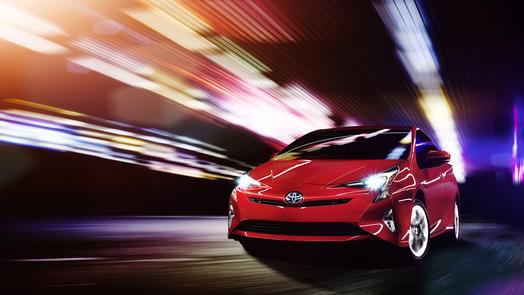
Prius became a driver’s friend.
The Prius is no longer merely the unshakable ecologist with strict principles driver willy-nilly had to accept if he wanted to live with it. Before, a lot of understanding and forgiving was needed from the driver part in order to choose and accept Prius.
With the new Prius, forced fuel-efficient driving style with loud engine resistance at a somewhat more decisive pace has become the past. Prius now wants drivers affection and is willing to listen to a wider range of driving desires. Now he understands the driver.
Prius IV is more mature and wants to continue the story of energy efficiency. But at the same time, Prius became a driver’s friend. Not only a friend of the most environmentally conscious drivers, historically low consumption hunters or trendy celebrities, but most drivers.
The fourth generation Toyota Prius, in addition to the high-tech improvement of the energy equation (in the direction of lower fuel consumption and lower emissions), accepted a new challenge. Mission: driver.
In other words, Prius 4 has a diploma in energy efficiency, but now also graduates from driving science. The package of education is very convincing.
Prius drives more vigorously
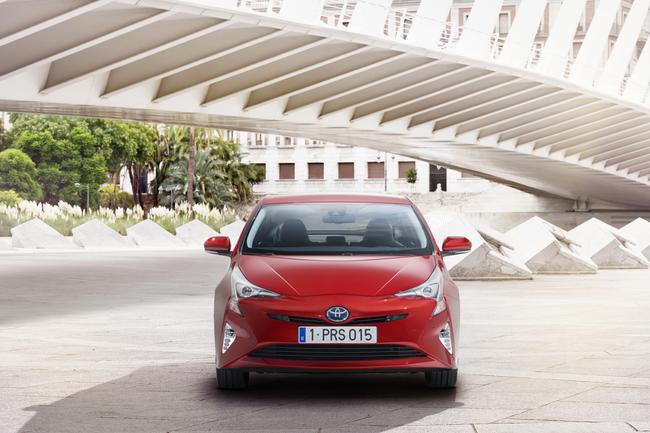
The difference in responsiveness and driving experience is incomparably better.
Despite the fact that the system power output is slightly lower, the new Toyota Prius has become much more decisive. Electricity is even more involved in energy flows. In particular in support of the drive in terms of responsiveness, in favor of acceleration and dynamic driving. On the road his unique continuously variable transmission with planetary interface, now accomplished with an additional system of gears and shafts, is able to more decisively support the increased motor speed.
In practice, this means that when you step on the accelerator, the Prius reacts faster. And without annoying high frequencies.
Raising the speed actually shows on the wheels and not in the loud noise. There are no more complaints, saying why are you rushing me, I drive economically. The transfer of electric and gasoline kilowatts to the wheels is much more pleasant.
The difference in responsiveness and driving experience is incomparably better. Do not get us wrong. The Prius is not an athlete. But now it responds as expected from a modern car. It does not matter whether it is in the city, on the highway or between rural turns. It drives more friendly than before, and serves the driver’s wishes. Its mission is willingness to compromise.
If we previously could not imagine to take a Toyota Prius on a long journey, today we can. With Prius artificial intelligence engineers even went so far, that a car in dynamic driving program “power” monitors drivers driving style. It learns what his owner wants from him. Accordingly, what the driver shows him behind the wheel, Toyota Prius tries to adapt. All Toyota hybrids should get this new drive interface as soon as possible. That puts the hybrid experience at least one class higher.
Toyota Prius digital senses helps the driver not to be involved in an accident
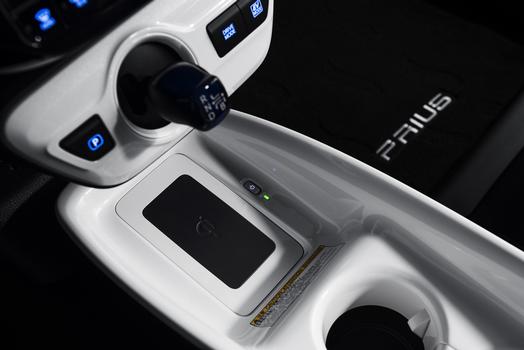
Transmission: continuously variable automatic with planetary gear system.
Since the Prius is the firstborn of new Toyota philosophy, engineers made every effort in the area of security. They want to achieve that Prius and its passengers remain intact. They promise a high level of active and passive safety. Around 400 Prius examples were crushed and carefully examined in the development stage. The vehicle they are sending on the road is ready for almost anything.
Three radars, two cameras, sonar and 17 different sensors take care that the Prius avoids accidents with cars or pedestrians with automatic braking, up to a speed of 40 kilometers per hour. They actively keep a safe distance, maintain the lane direction and monitor blind spots while driving and parking. All these electronic senses are set quite thoroughly. But we have noticed that in all the elements Prius electronic assistants are not as flawless and convincing as in some of the competitors. For example, in a little more demanding curve the steering wheel automatically adjusted the driving direction when the car already moved little across the line. However, the progress is obvious in the active cruise control and in the accuracy of reading road signs.
With all the technology Toyota Safety Sense offers in the new Prius, it is clear that in its fifth generation Prius may be able to drive on its own.
Board computer can calculate the fuel cost, the phone is fully charged without wires…
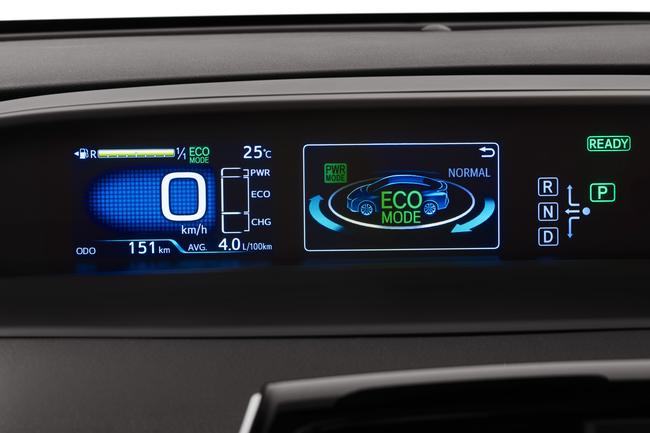
It is possible to enter the fuel prices into the board computer.
It is possible to enter the fuel prices into the board computer. Toyota Prius, given the data about consumption, calculates the cost of your mobility. Interesting.
Under the gearshift is a shelf for wireless smartphone charging with the Qi technology protocol. You can also get an adapter if your phone does not support this technology. Then simply place the phone and it starts to charge.
New, improved driver information system, more space for passengers
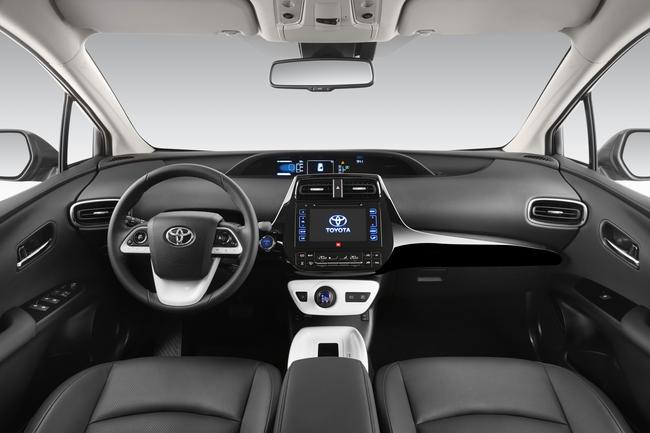
Monochrome screen was replaced with a larger 4.2-inch color screen.
The Toyota Prius of the fourth generation has a more dynamic exterior appearance, partly due to the LED headlights, which allowed designers more freedom. Inside there is a little more space than in the Prius of the third generation, especially in the width of the back seats. The seats in general are new and improved. They offer more comfort and better support the body.
The driver information system is also newly designed. Monochrome screen has withdrawn to a larger 4.2-inch color screen with higher resolution, some of the data are now also on the projection screen.
Toyota Prius real life consumption: under 5 liters
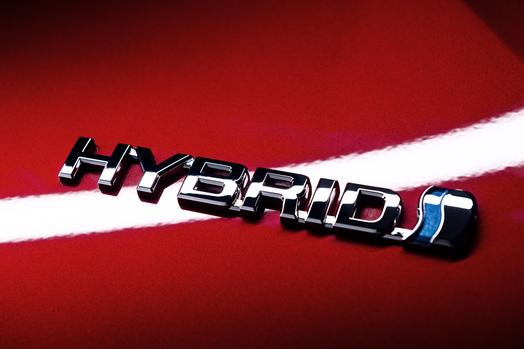
New Prius has 20 percent lower fuel consumption and lower emissions than predecessor.
If the previous generation Prius convinced us with its fuel efficiency, especially in urban traffic, the new engineering interventions in the understanding of energy significantly expanded the horizon of Toyota Prius ecology. The new hybrid system received a number of technical procedures with which they fundamentally intervened in energy management. It is interesting that at the press conference did not pay virtually no attention to driving only on electricity, although the Prius still knows to drive in the EV program all the way up to a speed of 60 kilometers per hour.
But electrical kilowatts play a very important role to strengthen the responsiveness and intervene in areas where gasoline horsepowers are too wasteful. The new control unit and the aforementioned planetary gearbox system all together beautifully folded into a whole. Progress is also visible on highways, where up to the speed of 110 kilometers per hour with the feet off the gas pedal means electrical sailing or driving with an extremely low energy consumption. An important new feature that Prius, as a pioneer in the segment, desperately needs.
The point of a new Prius is, of course, that it manages to catch all the energy that would otherwise be lost while driving. To take advantage of all sources of energy flow, produced with its own drive. To store that energy and use it, so that the energy equation is more balanced, sustainable, that every joule of energy comes to the right place at the right time.
Engineers have reduced friction losses in the engine and transmission. They improved the thermal monitoring, lubrication and the movement of exhaust gases. They installed new software that controls the hybrid drive, increased the electric motors efficiency and reduced the weight of all the components.
The result is excellent. 20 percent lower fuel consumption and lower emissions.
With a diverse, dynamic driving you will not get close to the factory promised consumption of three liters. We believe that the consumption measured in test laboratory could be approximated on the road, but in that case it would not be a normal driving experience. Nobody drives like that. The fact is that at the purely spontaneous driving, the new Toyota Prius consumption can be easily held under 5 liters, on average you can expect that Toyota Prius real life consumption is somewhere between 4.3 and 4.9 liters of fuel per 100 kilometers.
Can Toyota Prius compete with modern diesel engines?
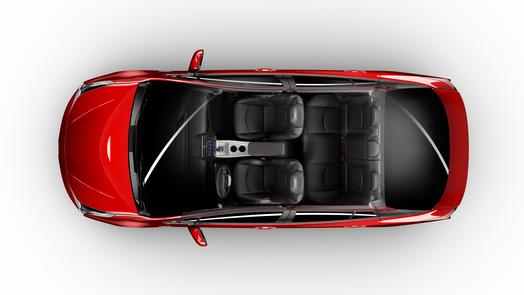
Inside there is a little more space than in the Prius of the third generation.
The fact is that the Toyota Prius is large enough, safe and comfortable family car. Due to the high-tech image and the environmental responsibility and low energy bill is also interesting for business garages. Because it can effectively reduce pollution and nitrogen oxides in large urban areas, the phrase Prius Taxi is self-evident. The question is, whether the new generation Prius is capable of competing with mid volume modern diesel engines. Especially in Europe.
With the energy? Definitely. With ecology? Yes. However, despite the exemplary progress in driving feeling and responsiveness, the Prius is not yet at the level of diesel engines in terms of torque and flexibility. But not far away and is getting closer. His era has only just begun. Diesel engines at this moment seems much too strong. But the automotive world is changing. Very quickly and unpredictably.
All the lies and scandals about unrealistic measurements will strengthen Toyota Prius presence. And with the rise of eco awareness among our civilization also comes to its account. The new Prius is certainly an interesting diesel competitor.
Above all, with his technique Prius deserves respect and consideration for everything that has been achieved, and what will certainly intend to do. Do not forget that around 24,000 US dollars (or similar amount in euros) investment in personal mobility of this type is an environmental investment. Investment that is backed up with a substantial package of engineering excellence, with the seal of reliability, security, high technology and unique image.
Toyota Prius World Premiere Event in Las Vegas
Toyota Prius technical specification
Vehicle class: Lower middle class, 5 seats, 5 doors.
Dimensions: Length: 4540 mm. Width: 1,760 mm. Height: 1470 mm. Wheelbase: 2700 mm. Luggage compartment: from 501 to 1,633 (last row folded) liters. Dimension of tires and wheels: 195/65 R15 or 215/45 R17. Drag coefficient: 0.24. Turning circle: 10.2 meters (15-inch wheels) or 10.8 meters (17-inch wheels). Towing capacity: from 725 kg (trailer without brakes). Fuel tank capacity: 43 liters.
Toyota Prius 1.8 VVT-i Hybrid engine and performance
Total system power of hybrid drive: 121 hp at 5200 rev/min.
Petrol engine: 4-cylinder engine (Atkinson cycle) DOHC 16V with electronic injection. Volume: 1798 cm3. Power: 95 hp. Torque: 142 Nm (105 lb ft) at 3600 rev/min.
Synchronous electric motor with permanent magnet: 71 hp and 163 Nm (120 lb ft)
Battery: Nickel Metal Hydride, 1.31 kWh, 201.6 V (nominal voltage).
Transmission: continuously variable automatic with planetary gear system. Front-wheel drive.
Weight: 1,375 kg.
Top speed: 180 km/h (112 mph).
Acceleration (0-100 km/h, 0-62 mph): 10.6 s.
Consumption: 3.0 l/100 km (15-inch wheels) or 3.3 l/100 km (17-inch wheels).
CO2 emissions: 70 g/km (15-inch wheels) or 76 g/km (17-inch wheels), EURO 6.
Price: from around 24,000 US dollars.
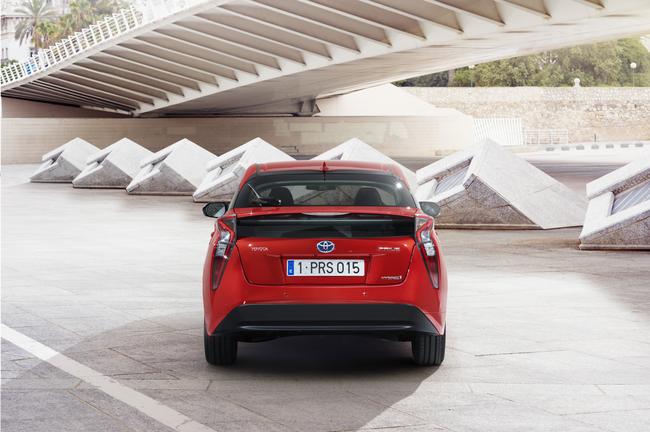
Toyota Prius Width: 1,760 mm.
Toyota Prius competitors and rivals
- BMW i3.
- Chevrolet Bolt EV.
- Chevrolet Volt.
- Ford C-Max Hybrid.
- Hyundai Ioniq (video comparison below).
- Lexus CT.
- Nissan Leaf.
- Opel/Vauxhall Ampera.
Toyota Prius vs Hyundai Ioniq
A tough battle between the Japanese and Korean. Prius and Ioniq are approximately the same size, with similar petrol and electric motor. Performance or fuel consumption are different by a small margin. Prius has a bit larger cargo volume, but again, nothing to brag about in front of Ioniq. The decisive factor could be the reputation (in favor of Prius) or the price (in favor of Ioniq).
Image credit: Toyota
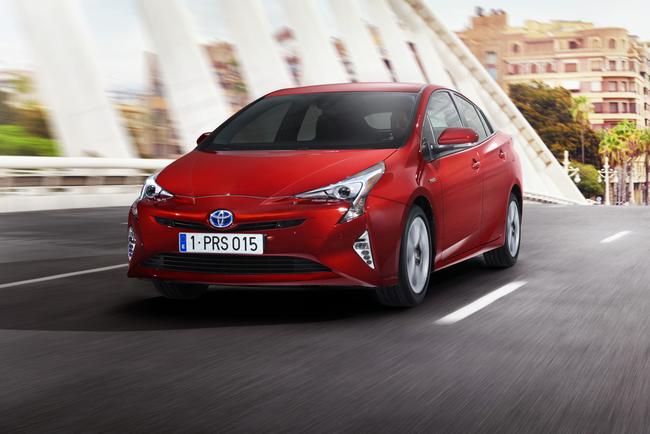

Be the first to comment on "2016 Toyota Prius – Ecological pioneer of modern time"